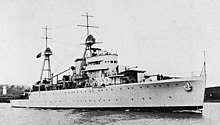Aviso (ship type)
An Aviso (Portuguese / Spanish for "announcement", "notification" or "report") was a fast, small warship used to transmit messages. Avisos were usually lightly armed and unarmored and also served as outpost, reconnaissance and liaison boats. They were also used as command ships and for light combat tasks in the colonial war.
German navies
The Prussian Navy requisitioned the wheel-driven 1420 t mail steamer Prussian Eagle from 1848 to 1849 as the first notification on the occasion of the Schleswig-Holstein War . The significantly smaller sister ships Nix and Salamander (430 t) followed as further radavisos in 1850 and the equally large Loreley in 1859 . These ships were supposed to serve as command ships for rowing cannon flotillas.
The Radaviso Falke (1230 t), bought in 1870, was the first Aviso to be armed with two rifled 12 cm ring cannons instead of smooth -barreled cannons . The ship with a speed of 12 knots was supposed to first use the then new tow torpedoes . After all, it served the armored ship squadron as a reconnaissance and signal repeater, which in future became the standard task of the German Avisos. The covered and smooth deck corvettes (later cruiser frigates or corvettes ) in service at that time were outdated in design and only suitable for school and foreign service, but not for service with the fleet.
The Zieten with a size of 1170 t (launched in 1877), which was first put into service as a torpedo vehicle, was the first screw-driven Aviso of the German Navy and, at 16 knots, was significantly faster than its predecessor. The ship was armed with two torpedo tubes and five revolver cannons.
The Blitz class of 1882 (1486 t) comprised the first steel ships of the Imperial Navy. The two following ships of the watch class (1887/8, 1499 t) were given an armored deck and an armored command post for the first time and thus resembled protected cruisers.
The Greif (1886, 2266 t) did not have auxiliary sails for the first time. In addition to two 10.5 cm ring cannons, the ship was armed with 10 3.7 cm revolver cannons, as it was also supposed to protect the large ironclad from torpedo attacks as a "torpedo boat hunter". This role was also intended for the two ships of the Meteor class (1890/2, 1072 t), which were the first to receive four fast-loading cannons of 8.8 cm caliber instead of the ring cannons that had been common up to that time . The ships were supposed to take on a role that the emerging torpedo boat destroyers played in other navies .
As the last advice of this line of development, the Hela , which weighs 2082 t and is equipped with armor protection, was put into service in 1896 . In 1899, the remaining Avisos, which had meanwhile all been armed with rapid-loading cannons, were classified as small cruisers as part of a reorganization of the type system .
Outside of this line of development are the various royal and imperial yachts that were also classified as Aviso, such as B. the Hohenzollern from 1880 and the Hohenzollern from 1893. These were normally not intended for combat duties, although the Cricket of 1858 actively participated in the second German-Danish War .
In 1935, the Navy took the 3430 t Aviso Grille into service as a test ship for high-pressure hot steam turbine propulsion systems. Later, the Grille was mainly used as a staff and station ship, but also as a mine-layer .
The last ship of the Kriegsmarine designated as Aviso was the Hela , which was put into service in 1940 , which resembled the Grille in terms of its hull, but with a displacement of 2520 t and a length of 99.8 m was somewhat smaller and equipped with diesel engines. She served the Admiral's staff as a command ship until the end of the war.
Navies of other nations
Portugal
Portugal put a number of gun and escort boats into service in the first half of the 20th century , known as Avisos. The last two, the Alfonso de Albuquerque and the Bartolomeu Dias (launched in 1934), were 1,780 t tall, ran 20 knots, were armed with four 12 cm guns and anti-aircraft weapons, and carried mines and a seaplane. The Alfonso de Albuquerque was destroyed on December 18, 1961 off Goa in a battle with the Indian cruiser Delhi and two destroyers.
France
The French Navy also had a number of gunboats in service in the first half of the 20th century, which were known as Aviso. Some of them were submarine traps . Many of the ships were intended for colonial service, four of which were used in the sea battle on the roadstead of Koh Chang . In this tradition, the French Navy also designated the frigates of the Commandant Rivière class (launched 1958–1963, 1700 t) and the D'Estienne d'Orves class, also known as the A69 type (launched 1973–1983 , 1090 t) as advice.
Web links
literature
- Hans H. Hildebrand, Albert Röhr, Hans-Otto Steinmetz: The German warships. Biographies; a mirror of naval history from 1815 to the present day . Koehlers Verlagsgesellschaft, Hamburg 1982/88, ISBN 3-7822-0236-8 (6 vols.).
- Weyer's Taschenbuch der Kriegsflotten , Vol. 35 (1941/42).
- Gerhard Albrecht (Ed.): Weyers Flottentaschenbuch 1994/96 . Bernard & Graefe Verlag, Bonn 1994, ISBN 3-7637-4507-6 .
- Helmut Pemsel : Command of the Sea . Bernard & Graefe Verlag, Koblenz 1995, ISBN 3-89350-711-6 .


